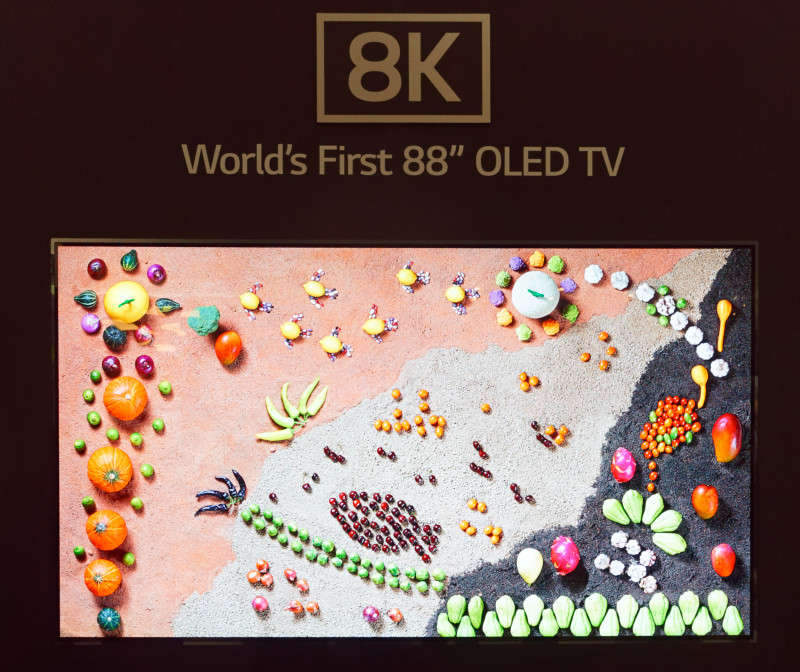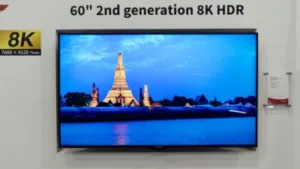Next generation advanced TV technologies are essential for market growth in 2019 and beyond as TV market growth rates have slowed down in recent years.

At the same time, massive 10.5 Gen LCD capacity is coming in over next three to four years that is optimized for 65-inch and above size TV panels (as Bob pointed out in his DD Here We Go on the Downside of the LCD Crystal Cycle). Fear of panel oversupply is looming large in future years. Advanced TV technologies can provide better performance, boost replacement demand, drive growth, and reduce oversupply.
Super Size TVs
The growth of 8.5 Gen fabs, which are efficient for 55-inch (6-up) size panels, combined with UHD 4 K resolutions enabled the shift to large-size TV in the last few years. By 2020, more than four to five 10.5 Gen fabs will be coming, optimized for 65-inch (8-up) and 75-inch (6-up) TV panels. Suppliers are hoping to replace 55-inch TV sales with 65-inch.
Prices of 65-inch and 75-inch TVs are expected to reduce significantly in future due to increased efficiency and competition. These 65-inch and above size TVs need to be combined with better features, higher performance, higher resolutions and lower prices to increase demand. Above 65-inch size TV are expected to have strong growth in the next three years.
High Resolutions: 4K and 8K
UltraHD 4K TVs were commercially released in 2013 and 4K content streaming service and OTT started in 2014. Sharp introduced 8K TV in 2017, mostly to the commercial market and with very limited shipments. 2018 saw the introduction of more 8K TVs, especially at IFA in August. Samsung introduced its QLED 8K (7,680x 4,320 pixels) TV that is 16 times more than FHD (1920x 1080) and four times higher than 4K (3840x 2160). Based on quantum dot and LCD technology it boasts 4000 cd/m² of peak brightness.
8K TVs with higher transmittance enable the display of finely detailed images with higher perceptual depth and creating a more immersive experience. But 8K content is really lacking in the industry. Samsung’s machine learning system is automatically up-scaling 4K content for 8K TV (and is getting good reviews for its performance – BR).
History has shown that consumers shift to higher resolutions to “future proof” their purchases. The Tokyo Olympics (2020) being broadcast in 8K combined with 5G networks is expected to help 8K TV adoption. It is also the time when large capacity will be coming from many 10.5 Gen fabs in China including LGD’s OLED fab. LG showcased an 88-inch 8K OLED TV protottype also at IFA. Sharp showcased its second generation 8K TV.
By 2019, more than 50% of the TV shipments will be UltraHD displays. Even though there is an argument against a real need for 8K TV, manufacturers feel they need to bring in next generation technology to drive demand.
 Sharp’s 8K sets at IFA. Image:Meko
Sharp’s 8K sets at IFA. Image:Meko
MiniLED backlight empowering LCD
MiniLED can help LCDs by improving contrast ratio, increasing color gamut, reducing response time, and increasing brightness. MiniLED backlights can also be combined with direct backlight and local area dimming, to provide very high contrast and better HDR performance. Performance can even improve further with the use of Quantum Dot technology. However, higher cost is a major issue with MiniLED backlight.
Also as the number of chips increases significantly, it may lead to longer processing time, lower yield, bonding issues and other challenges. High cost may restrict the concept to the high-end TV market, initially. It could help to reduce the performance gap between LCD and OLED TV. In the long run, if cost can be reduced, it could open up new opportunities for TVs by triggering replacement demand. MiniLED TV is expected to come in 2019, but it may be 2020 or even longer before significant cost reductions can be achieved.
Quantum Dot coming to LCD’s rescue
Quantum Dot (QD) display technology has the potential to be a disruptive force to enable next generation LCD, MicroLED and OLED. It can ultimately create an emissive display to compete directly with OLED display. Quantum dot can really empower LCD TV by enabling higher brightness (4000 cd/m² and above) and a significant increase in the color gamut (supporting more of BT 2020).
QD technology can bring LCD TV performance closer to OLED and enable OLED to exceed LCD in certain areas. In recent years, there have been various quantum dot technologies and applications available or under development for display (QDEF replacement films, QD on glass light guide plate, QD color convertor replacing color filters, and Electro Emissive QD).
Samsung QLED TVs have been in the forefront, serving the premium market. In 2018, Vizio’s QD 4K TV is starting to reach below $1500 for a 65-inch model. Samsung products are also reaching below $2000, opening up new opportunities especially in the premium mid-range. Chinese brands, TCL and Hisense have also joined in (although Hisense now also has an OLED TV – BR). With massive larger size LCD capacity coming, quantum dot can come to the rescue by providing ultra high brightness, super wide color gamut and differentiating product to boost TV replacement demand.
OLED poised for next gen TV
OLED has achieved increased market shares in recent years with superior picture quality, design differentiation, higher capacity and adoption by multiple TV brands. Self-emissive pixel dimming of OLED enables perfect black and infinite contrast ratio providing great picture quality. LG Display’s OLED TV panel is based on white OLED on Oxide TFT substrate.
LG Electronics showcased an 88-inch 8K OLED TV prototype at IFA. LG Display will significantly increase its OLED panel capacity in 2019 and 2020. By 2020 it plans to start mass production in its 10.5 Gen fab. One of the main challenges is the manufacturing cost of white OLED. Adoption of ink jet printing may help to reduce the manufacturing cost in future but it still needs improvement in material efficiency and lifetime especially for the blue emitter.
Still, OLED capacity for TV is small compared to LCD. OLED has shifted to 65-inch and above. Suppliers are bringing in new materials and new processes in 2019 and beyond to drive growth.
 LG’s prototype 8K OLED TV, shown at IFA. Image:Meko
LG’s prototype 8K OLED TV, shown at IFA. Image:Meko
Quantum Dot OLED is coming
Samsung Display is building a pilot production facility for QD OLED panels with capacity of 5K per month of Gen 8.5, which will start production in 2019, according to DSCC. If it is successful, Samsung will double the capacity in 2020 and then increase again in 2021 and 2022. According to Nanosys, it is much more efficient to replace the color filter in white OLED for TV with Quantum Dot Colour Conversion (QDCC) for greater luminance and increased color gamut. It also simplifies panel structure and fabrication process and eliminates shadow mask patterning. However the process needs highly efficient blue OLED materials with long lifetime.
The next few years will be challenging and exciting for the TV market. Massive 10.5 Gen LCD capacity will be coming in next three to four years that are optimized for 65-inch and above size TV. LG Display will be also increasing OLED capacity while Samsung will be starting Quantum Dot OLED production. Next Generation TV technologies are essential to provide better performance, boost replacement demand, drive growth, and reduce over-supply.
Sweta Dash, President, Dash-Insights
Sweta Dash is the founding president of Dash-Insights, a market research and consulting company specializing in the display industry. For more information, contact [email protected] or visit www.dash-insight.com

